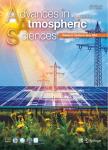Homogenized Daily Relative Humidity Series in China during 1960?2017
Homogenized Daily Relative Humidity Series in China during 1960-2017作者机构:Key Laboratory of Regional Climate-Environment in Temperate East AsiaInstitute of Atmospheric PhysicsChinese Academy of SciencesBeijing 100029China University of Chinese Academy of SciencesBeijing 100049China National Meteorological Information CenterChina Meteorological AdministrationBeijing 100081China University of EdinburghEdinburgh EH89YLUnited Kingdom
出 版 物:《Advances in Atmospheric Sciences》 (大气科学进展(英文版))
年 卷 期:2020年第37卷第4期
页 面:318-327页
核心收录:
学科分类:07[理学] 070601[理学-气象学] 0706[理学-大气科学]
基 金:the Chinese Academy of Sciences(Project Nos.XDA19030402 and XDA20020201) the UK–China Research&Innovation Partnership Fund through the Met Office Climate Science for Service Partnership(CSSP)China as part of the Newton Fund(SFBT&NF)
主 题:relative humidity homogenization observation system changes MASH(Multiple Analysis of Series for Homogenization)
摘 要:Surface relative humidity(RH)is a key element for weather and climate monitoring and ***,RH is not as commonly applied in studying climate change,partly because the observation series of RH are prone to inhomogeneous biases due to non-climate changes in the observation system.A homogenized dataset of daily RH series from 746 stations in Chinese mainland for the period 1960–2017,ChinaRHv1.0,has been ***(685 or 91.82%of the total)station time series were inhomogeneous with one or more break *** major breakpoints occurred in the early 2000s for many stations,especially in the humid and semi-humid zones,due to the implementation of automated observation across the *** inhomogeneous biases in the early manual records before this change are positive relative to the recent automatic records,for most of the biased station *** are more break points detected by using the MASH(Multiple Analysis of Series for Homogenization)method,with biases mainly around?0.5%and 0.5%.These inhomogeneous biases are adjusted with reference to the most recent observations for each *** on the adjusted observations,the regional mean RH series of China shows little long-term trend during 1960–2017[0.006%(10 yr)^?1],contrasting with a false decreasing trend[?0.414%(10 yr)?1]in the raw *** is notable that ERA5 reanalysis data match closely with the interannual variations of the raw RH series in China,including the jump in the early 2000s,raising a caveat for its application in studying climate change in the region.



